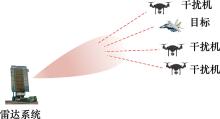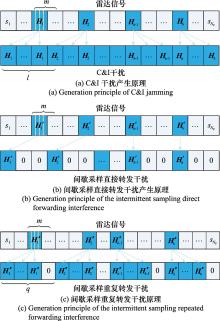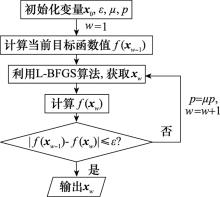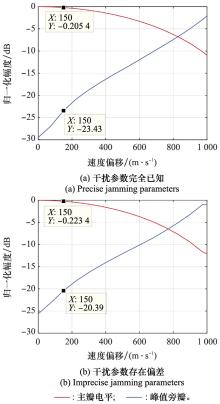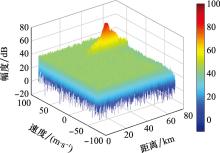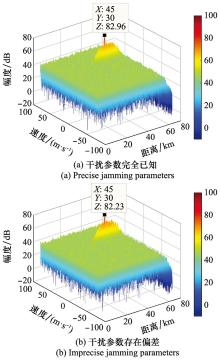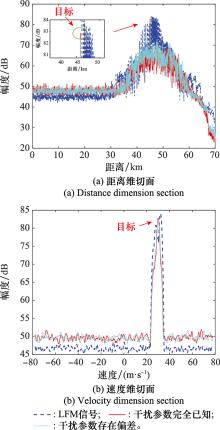Systems Engineering and Electronics ›› 2023, Vol. 45 ›› Issue (11): 3437-3448.doi: 10.12305/j.issn.1001-506X.2023.11.09
• Sensors and Signal Processing • Previous Articles Next Articles
Joint cognitive design method of waveform and filter for multi-mainlobe jamming
Yu LIN, Yi BU, Xianxiang YU, Guolong CUI
- School of Information and Communication Engineering, University of Electronic Science and Technology of China, Chengdu 611731, China
-
Received:2022-03-28Online:2023-10-25Published:2023-10-31 -
Contact:Xianxiang YU
CLC Number:
Cite this article
Yu LIN, Yi BU, Xianxiang YU, Guolong CUI. Joint cognitive design method of waveform and filter for multi-mainlobe jamming[J]. Systems Engineering and Electronics, 2023, 45(11): 3437-3448.
share this article
| 1 |
ALFONSO F , FULVIO G . Calculation of blanking probability for the sidelobe blanking for two interference statistical models[J]. IEEE Signal Processing Letters, 1998, 5 (4): 98- 100.
doi: 10.1109/97.664178 |
| 2 | KEIZER W P M N . Fast low-sidelobe synthesis for large planar array antennas utilizing successive fast Fourier transforms of the array factor[J]. IEEE Trans. on Antennas & Propagation, 2007, 55 (3): 715- 722. |
| 3 | VENDIK O G , KOZLOV D S . Phased antenna array with a sidelobe cancellation for suppression of jamming[J]. IEEE Antennas & Wireless Propagation Letters, 2012, 11, 648- 650. |
| 4 |
唐斌, 赵源, 蔡天一, 等. 雷达抗有源干扰技术现状与展望[J]. 数据采集与处理, 2016, 31 (4): 623- 639.
doi: 10.16337/j.1004-9037.2016.04.001 |
|
TANG B , ZHAO Y , CAI T Y , et al. Advances and perspectives in radar ECCM techniques of active jamming[J]. Journal of Data Acquisition and Processing, 2016, 31 (4): 623- 639.
doi: 10.16337/j.1004-9037.2016.04.001 |
|
| 5 |
DAI H Y , WANG X S , LI Y Z , et al. Main-lobe jamming suppression method of using spatial polarization characteristics of antennas[J]. IEEE Trans. on Aerospace and Electronic Systems, 2012, 48 (3): 2167- 2179.
doi: 10.1109/TAES.2012.6237586 |
| 6 | 杨志群, 倪晋麟, 储晓彬, 等. 关于主瓣干扰抑制技术的研究[J]. 电波科学学报, 2003, (2): 147- 152. |
| YANG Z Q , NI J L , CHU X B , et al. Research on suppression technology of mainlobe interference[J]. Chinese Journal of Radio Science, 2023, 2 (147): 152. | |
| 7 | HUANG G M, YANF L X, SU G Q. Blind source separation used for radar anti-jamming[C]//Proc. of the International Conference on Neural Networks and Signal Processing, 2003: 1382-1385. |
| 8 | 黄高明, 杨绿溪, 何振亚. 一种基于盲源分离的雷达抗干扰技术[J]. 电路与系统学报, 2004, (6): 94- 99. |
| HUANG G M , YANG L X , HE Z Y . A radar anti-jamming technology based on blind source separation[J]. Journal of Circuits and Systems, 2004, 6, 94- 99. | |
| 9 | 王建明, 伍光新, 周伟光. 盲源分离在雷达抗主瓣干扰中的应用研究[J]. 现代雷达, 2010, 32 (10): 46- 49. |
| WANG J M , WU G X , ZHOU W G . A study on radar mainlobe jamming suppression based on blind source separation algorithm[J]. Modern Radar, 2010, 32 (10): 46- 49. | |
| 10 | GE M M, CUI G L, SHI Q, et al. Mainlobe jamming suppression based on joint blind source separation for distributed radar[C]//Proc. of the IEEE Radar Conference, 2019. |
| 11 | DU D P, TANG B. Noise FM jamming suppression via logarithm transform[C]//Proc. of the International Conference on Communications, Circuits and Systems, 2008: 957-959. |
| 12 |
YANG X P , XI P L , ZHENG T , et al. Applying auxiliary array to suppress mainlobe interference for ground-based radar[J]. IEEE Antennas and Wireless Propagation Letters, 2013, 12, 433- 436.
doi: 10.1109/LAWP.2013.2254698 |
| 13 |
YANG X P , ZHANG Z G , ZHENG T , et al. Mainlobe interference suppression based on eigen-projection processing and covariance matrix reconstruction[J]. IEEE Antennas and Wireless Propagation Letters, 2014, 13, 1369- 1373.
doi: 10.1109/LAWP.2014.2339224 |
| 14 | ZHOU C, SHI F Q, LIU Q H. Research on parameters estimation and suppression for C&I jamming[C]//Proc. of the CIE International Conference on Radar, 2016. |
| 15 | ZHANG S, YANG Y, CUI G L, et al. Range-velocity jamming suppression algorithm based on adaptive iterative filtering[C]//Proc. of the IEEE Radar Conference, 2016. |
| 16 | ZHOU C , LIU Q H , CHEN X L . Parameter estimation and suppression for DRFM-based interrupted sampling repeater jammer[J]. IET Radar, Sonar & Navigation, 2017, 12 (1): 56- 63. |
| 17 |
CUI G L , JI H M , CAROTENUTO V , et al. An adaptive sequential estimation algorithm for velocity jamming suppression[J]. Signal Processing, 2017, 134, 70- 75.
doi: 10.1016/j.sigpro.2016.11.012 |
| 18 | CHEN X Z , SHU T , YU K B , et al. Joint adaptive beamforming techniques for distributed array radars in multiple mainlobe and sidelobe jammings[J]. IEEE Antennas and Wireless Propagation Letters, 2019, 19 (2): 248- 252. |
| 19 | AKHTAR J. An ECCM scheme for orthogonal independent range-focusing of real and false targets[C]//Proc. of the IEEE Radar Conference, 2007, 846-849. |
| 20 | AKHTAR J . Orthogonal block coded ECCM schemes against repeat radar jammers[J]. IEEE Trans. on Aerospace and Electronic Systems, 2009, 45 (3): 1218- 1226. |
| 21 | 周畅, 汤子跃, 余方利, 等. 基于脉内正交的抗间歇采样转发干扰方法[J]. 系统工程与电子技术, 2017, 39 (2): 269- 276. |
| ZHOU C , TANG Z Y , YU F L , et al. Anti intermittent sampling repeater jamming method based on intrapulse orthogona-lity[J]. Systems Engineering and Electronics, 2017, 39 (2): 269- 276. | |
| 22 | 吴少鹏, 袁越, 涂刚毅. 间歇采样干扰识别的抗欺骗干扰波形设计[J]. 现代防御技术, 2018, 46 (2): 75- 81. |
| WU S P , YUAN Y , TU G Y . Design of anti deception jamming waveform for intermittent sampling interference identification[J]. Modern Defence Technology, 2018, 46 (2): 75- 81. | |
| 23 | 徐磊磊. 雷达波形设计及抗主瓣有源干扰若干技术研究[D]. 西安: 西安电子科技大学, 2019. |
| XU L L. Researches on radar waveform design and several techniques of mainlobe active interference suppression[D]. Xi'an: Xidian University, 2019. | |
| 24 | 葛萌萌. 认知雷达多维联合抗主瓣干扰研究[D]. 成都: 电子科技大学, 2021. |
| GE M M. Cognitive radar mainlobe jamming suppression methods via multidimensional signal design and processing[D]. Chengdu: University of Electronic Science and Technology of China, 2021. | |
| 25 | 余若峰, 杨威, 付耀文, 等. 面向不同雷达任务的认知波形优化综述[J]. 电子学报, 2022, 50 (3): 726- 752. |
| YU R F , YANG W , FU Y W , et al. A review on cognitive waveform optimization for different radar missions[J]. Acta Electronica Sinica, 2022, 50 (3): 726- 752. | |
| 26 | 徐磊磊, 臧会凯, 周生华, 等. 一种相位编码信号及其失配滤波器设计方法[J]. 西安交通大学学报, 2016, 50 (4): 54- 59. |
| XU L L , ZANG H K , ZHOU S H , et al. A designed method of phase code waveform and its mismatched filter[J]. Journal of Xi'an Jiaotong University, 2016, 50 (4): 54- 59. | |
| 27 | 崔国龙, 余显祥, 杨婧, 等. 认知雷达波形优化设计方法综述[J]. 雷达学报, 2019, 8 (5): 537- 557. |
| CUI G L , YU X X , YANG J , et al. An overview of waveform optimization methods for cognitive radar[J]. Journal of Radar, 2019, 8 (5): 537- 557. | |
| 28 | 余显祥, 路晴辉, 杨婧, 等. 短基线收发分置频域协同波形设计方法[J]. 雷达学报, 2022, 11 (2): 227- 239. |
| YU X X , LU Q H , YANG J , et al. Frequency domain cooperative waveform design method for short baseline transceiver[J]. Journal of Radars, 2022, 11 (2): 227- 239. | |
| 29 | 崔国龙, 樊涛, 孔昱凯, 等. 机载雷达脉间波形参数伪随机跳变技术[J]. 雷达学报, 2022, 11 (2): 213- 226. |
| CUI G L , FAN T , KONG Y K , et al. Pseudo-random agility technology for interpulse waveform parameters in airborne radar[J]. Journal of Radars, 2022, 11 (2): 213- 226. |
| [1] | Luwei FENG, Songtao LIU, Huazhi XU. Intelligent radar jamming decision-making method based on POMDP model [J]. Systems Engineering and Electronics, 2023, 45(9): 2755-2760. |
| [2] | Husheng WANG, Baixiao CHEN, Qingzhi YE. Research on anti-chaff jamming method based on measured data [J]. Systems Engineering and Electronics, 2023, 45(7): 2010-2021. |
| [3] | Jinyang HE, Ziyang CHENG, Zhanlei LI, Zishu HE, Minghui SHA. Low Doppler sensitive waveform design method against interrupted sampling repeater jamming [J]. Systems Engineering and Electronics, 2023, 45(5): 1333-1341. |
| [4] | Dong XIA, Kaixuan ZHANG, Youbao DING, Baopeng LI. Co-channel interference resistance based on agile wave form of phase encode and CFAR technology [J]. Systems Engineering and Electronics, 2022, 44(4): 1210-1219. |
| [5] | Dong FU, Jing PENG, Ming MA, Feiqiang CHEN, Gang OU. GNSS time spoofing detection and discrimination based on clock bias hypothesis test [J]. Systems Engineering and Electronics, 2022, 44(3): 948-955. |
| [6] | Shuai ZHAO, Songtao LIU, Huiyang WANG. LPI radar waveform recognition algorithm based on PSO-CNN [J]. Systems Engineering and Electronics, 2021, 43(12): 3552-3563. |
| [7] | Jinyang HE, Ziyang CHENG, Zishu HE. Cognitive constant modulus waveform design method against interrupted sampling repeater jamming [J]. Systems Engineering and Electronics, 2021, 43(9): 2448-2456. |
| [8] | Xiaoge WANG, Hui CHEN, Mengyu NI, Liuliu NI, Bingbing LI. Radar anti-false target jamming method based on phase modulation [J]. Systems Engineering and Electronics, 2021, 43(9): 2476-2483. |
| [9] | Dongxia LI, Qiuyu CHEN, Lei WANG, Haitao LIU. DME pulse interference suppression method based on BSBL-BO algorithm [J]. Systems Engineering and Electronics, 2021, 43(9): 2649-2656. |
| [10] | Juntao ZHANG, Shangsheng LI, Xukun WANG. Method of radar anti-jamming performance evaluation based on grey correlation-fuzzy comprehensive evaluation [J]. Systems Engineering and Electronics, 2021, 43(6): 1557-1563. |
| [11] | Haiyang WANG, Zhicheng YAO, Zhiliang FAN, Jinying WU, Guangbin LIU. Anti-jamming algorithm for GNSS receivers with array antenna in high speed environment [J]. Systems Engineering and Electronics, 2020, 42(11): 2409-2417. |
| [12] | Haitao LIU, Guangxue LI, Haixia SUN, Lei WANG. L-DACS1 system interference suppression and cyclic adaptive beamforming method [J]. Systems Engineering and Electronics, 2020, 42(8): 1850-1856. |
| [13] | Yalan LI, Weidong JIN, Peng GE. Radiation emitter signal recognition based on VMD and feature fusion [J]. Systems Engineering and Electronics, 2020, 42(7): 1499-1503. |
| [14] | Xijun GAO, Hongxia JIA, Zili CHEN, Guogang YUAN. Anti-jamming method of OFDM wide-band measuring and controlling based on adaptive sensing [J]. Systems Engineering and Electronics, 2020, 42(5): 1166-1172. |
| [15] | FENG Qi, ZHU Chang, YUAN Nai-chang. Design of anti-jamming adaptive antennas for GPS receivers [J]. Journal of Systems Engineering and Electronics, 2009, 31(7): 1556-1559. |
| Viewed | ||||||
|
Full text |
|
|||||
|
Abstract |
|
|||||
